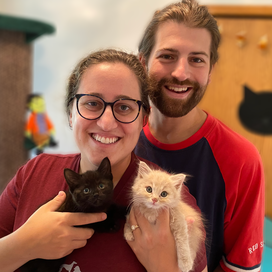"A concerted effort to decrease or eliminate inappropriate antibiotic use can have a big impact on patient safety and the problem of antibiotic resistance."

Epidemiologist and Program Manager for Antimicrobial Stewardship
University of Minnesota College of Veterinary Medicine
|
How does your work involve antibiotic use?
I am an epidemiologist at the University of Minnesota College of Veterinary Medicine. In my role, I manage two research initiatives to better understand how antibiotics are used in dogs and cats: 1) point-prevalence surveys (uniform data collection from a single day of clinical practice from many veterinary clinics into a shared database) and 2) Companion Animal Veterinary Surveillance Network (CAVSNET) (electronic disease surveillance system that combines veterinary practice data from various electronic health record systems into a common data model for research and surveillance purposes to improve pet health). Both of these initiatives collect information about what antibiotics are prescribed and for which clinical conditions.
From your perspective, what is most challenging about antibiotic prescribing and stewardship?
Antibiotics are critical in human and veterinary medicine; however, widespread use and misuse of antibiotics is a major driver of antibiotic resistance. Working closely with veterinarians who prescribe antibiotics, I hear stories about the pressures to prescribe antibiotics even when they are not warranted or in the case of diagnostic uncertainty. I think a major challenge in veterinary medicine is the cost of diagnostic testing. Oftentimes the cost of a test can be very expensive, particularly given the lack of pet insurance. Pet owners cannot afford the tests to confirm a bacterial infection, and thus, antibiotics are prescribed without knowing the etiology of the problem. Additionally, veterinary staff often lack time that can be dedicated to antibiotic stewardship activities. Lastly, I think there is a lack of awareness by veterinary professionals of the published antibiotic use prescribing guidelines. There also needs to be more published prescribing guidelines for veterinarians for commonly encountered conditions in which antibiotics are often prescribed, but antibiotics are not typically warranted, such as non-infectious acute gastrointestinal diseases.
What is your professional experience with antibiotic resistance?
Measurement and tracking of antibiotic use and antibiotic-resistant organisms is critical to our ability to practice antibiotic stewardship. The studies referenced above identify situations in which antibiotics are used that may be contributing to antibiotic-resistant infections in dogs and cats. Without antibiotic use data, we cannot determine how well the veterinary profession is adhering to published antibiotic use prescribing guidelines and whether we are improving over time. A concerted effort to decrease or eliminate inappropriate use can have a big impact on patient safety and the problem of antibiotic resistance.
How has antibiotic resistance or antibiotic use affected your work?
Part of my work has focused on developing clinical resources for veterinary professionals about how to implement antibiotic stewardship initiatives within the clinic. These tools have been developed based on the needs of the veterinary profession in regards to antibiotic prescribing and antibiotic resistance. These free online clinical resources and tools discuss practical steps that every clinic can take, no matter how big or small of a practice, to better improve antibiotic prescribing.
What worries you most about antibiotic resistance as a professional and person?
Professionally, I am worried about the lack of funding that is dedicated to better understand antibiotic use and antibiotic resistance in dogs and cats. Personally, I am worried that if we are not careful about how and when antibiotics are used, we could lose this vital tool to treat infections in both animals and people.
|